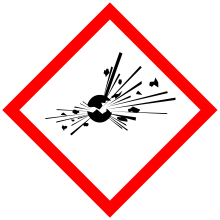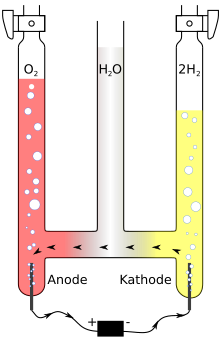Oxyhydrogen

Electrolytic gas , also known as oxyhydrogen in English-speaking countries , is a detonable mixture of gaseous hydrogen (H 2 ) and oxygen (O 2 ). When it comes into contact with an open fire (embers or sparks), the so-called oxyhydrogen reaction occurs. A finished mixture of hydrogen and oxygen in a molar ratio of 2: 1 is explosive even in small quantities. If, on the other hand, only hydrogen is used as the starting product and it is mixed with air under atmospheric pressure, the volume percentage of hydrogen must be between 18 and 76 % by volume . If these limit values are fallen below or exceeded, an explosion / detonation no longer occurs . Mixtures of air and 4 to 18% by volume of hydrogen are flammable but not explosive. A continuous oxyhydrogen gas flame can be achieved through controlled combustion at a mixing nozzle .
Théodore Turquet de Mayerne (around 1620) and Robert Boyle (around 1670) observed the formation of oxyhydrogen in the 17th century through the action of acids on metals. Henry Cavendish and Joseph Priestley followed in the 1770s and 1780s .
Manufacturing
Oxyhydrogen can be produced by water electrolysis , i.e. the electrolytic decomposition of water (H 2 O) or by the thermal decomposition of water. The thermal decomposition of water requires temperatures above 2500 ° C.
In water electrolysis , the splitting takes place with the help of electric current . The electrodes are immersed in water that has been made more electrically conductive by adding a little acid , preferably sulfuric acid , or lye . To be on the safe side, the gases bubbling up from the two electrodes are separated - i.e. the hydrogen above the cathode (negative pole).
Oxyhydrogen reaction
The oxyhydrogen reaction is an exothermic and detonation-like reaction of hydrogen with oxygen and runs at a detonation speed of 2820 m / s. It is a form of combustion ( oxidation ).
The reaction equation is:
It is a highly branched chain reaction (chain branching explosion ) involving hydrogen, oxygen and hydroxyl - radicals as chain carrier.
and other reactions
The reaction product is water .
The energy released per molar formula conversion is 571.6 kJ / mol (Δ r H 0 = −571.6 kJ / mol). This changes the enthalpy H for one mole of the resulting water by −286 kJ / mol.
Hydrogen peroxide is also formed as a side reaction according to:
The oxyhydrogen reaction is strongly pressure and temperature dependent. At very low pressures, the resulting chain carriers can reach the vessel wall and recombine there. This prevents chain lengthening or branching and prevents an explosion. If the pressure is increased, the mixture reaches the lower explosion limit. The mean free path has now become so small that the chain carriers collide with other particles before reaching the vessel walls and continue the chain reaction. If the pressure is increased further, the system reaches the upper explosion limit. The high pressure increases the probability of three-particle collisions, so chain carriers can also recombine in the gas phase and the chain reaction is broken off. At even higher pressures, a thermal explosion finally occurs. Here, the energy released during the reaction can no longer be dissipated quickly enough and the reaction temperature is increased. This leads to further reactions, the energy of which in turn can no longer be dissipated. The thermal explosion is based on a drastic increase in temperature and not on a chain branching reaction.
In the mitochondria of living cells , the end oxidation in complex IV in the respiratory chain leads to an analogous, but strictly controlled, exergonic reaction (sometimes, not quite correctly, referred to as a "biological oxyhydrogen reaction"). H. serves to form ATP molecules:
The free enthalpy ΔG ° 'of the reaction results from its redox potential (+0.5 V) and under physiological conditions (pH 7) is −193 kJ / mol.
The same reaction also takes place in the fuel cell . In their construction, the energy released during the oxyhydrogen reaction ( enthalpy difference ), here more precisely: free enthalpy or Gibbs energy ΔG, is used without causing an explosion . The enthalpy that is released is partly released as electrical current and partly as heat. However, the reaction in the fuel cell takes place slowly and in a controlled manner.
Oxyhydrogen sample
In chemistry, the term oxyhydrogen sample denotes evidence of hydrogen . However, this is unspecific, since z. B. Methane forms oxyhydrogen with oxygen and is only used as a pseudo-proof in chemistry classes. The actual use (see below) is to check the air content of a hydrogen producing apparatus.
For the detection, the gas to be checked is usually held in a test tube with the opening facing downwards, so that hydrogen cannot escape due to its lower density than air, near an ignition source - such as a Bunsen burner or lighter .
Case 1: The gas collected is pure hydrogen. A quiet combustion or possibly a weak deflagration (negative oxyhydrogen gas sample) occurs.
Case 2: The gas collected is a mixture of hydrogen and oxygen (oxyhydrogen). The combustion takes place with a whistling noise (positive detonating gas sample).
Due to the different noises made by pure hydrogen and the mixture of hydrogen and oxygen, the oxyhydrogen gas sample is also used to check the purity of hydrogen gas in order to avoid an explosion in a closed vessel.
Similar to oxyhydrogen, the chlorinated oxyhydrogen explodes .
application
Johann Wolfgang Döbereiner discovered that the oxyhydrogen reaction can also be set in motion by a platinum wire as a catalyst . A few years later he succeeded in igniting an oxyhydrogen gas mixture under the influence of a platinum sponge . This discovery led to the invention of the first lighter (the Döbereiner platinum lighter ).
Accidents
There have already been many accidents worldwide due to oxyhydrogen explosions, some of them catastrophic. The often mentioned crash of the Hindenburg Zeppelin in 1937, where when approaching the anchor mast, the hydrogen gas escaped into the air atmosphere through a minor leak, causing a huge hydrogen fire, was not an oxyhydrogen reaction because the volume fraction of the Hydrogen was too high and the oxygen concentration in the air was too low.
More recently, hydrogen explosions have become particularly well known in the 1986 Chernobyl disaster and in 2011 the Fukushima nuclear disaster .
literature
- Gerhart Jander, Hans Spandau, Jürgen Fenner, Rolf Minkwitz: Short textbook of inorganic and general chemistry. 10th edition, Springer, Berlin / Heidelberg 1987, ISBN 978-3-540-16749-5 .
- Peter W. Atkins, Julio de Paula: Short textbook of physical chemistry . 4th edition. Wiley-VCH, Weinheim 2008, ISBN 978-3-527-31807-0 , pp. 512-513 .
Individual evidence
- ↑ Basics of Inorganic Chemistry I: Main Group Elements (PDF; 722 kB), 2003.
- ↑ Peter W. Atkins, Julio de Paula: Short textbook of physical chemistry . 4th edition. Wiley-VCH, Weinheim 2008, ISBN 978-3-527-31807-0 , pp. 512-513 .
- ^ Aircraft disasters , Gondrom-Verlag (ed.), 1996.







